Food, Nutrition, and Health: Betty's Dietary Intake Analysis Report
VerifiedAdded on 2020/05/16
|10
|2956
|34
Report
AI Summary
This report analyzes the dietary intake and health of a 48-year-old woman named Betty. It begins by calculating her Basal Metabolic Rate (BMR) and Estimated Energy Requirement (EER) based on her age, height, weight, and activity level. The report then compares her actual nutrient intake to the Recommended Daily Intake (RDI) and Acceptable Macronutrient Distribution Range (AMDR), highlighting discrepancies in protein, fat, and carbohydrate consumption. It emphasizes the risks associated with her high-energy intake, including potential development of type 2 diabetes, obesity, and cardiovascular diseases. The report also discusses the importance of physical activity and genetic factors in cardiovascular health, noting Betty's family history and sedentary lifestyle. Finally, the report recommends dietary changes, including a low-fat diet, increased water intake, and adherence to dietary guidelines like the Australian Dietary Guidelines, to reduce her risk of developing lifestyle diseases and maintain a healthy weight. It also emphasizes the importance of physical activity and offers recommendations for a healthier lifestyle.
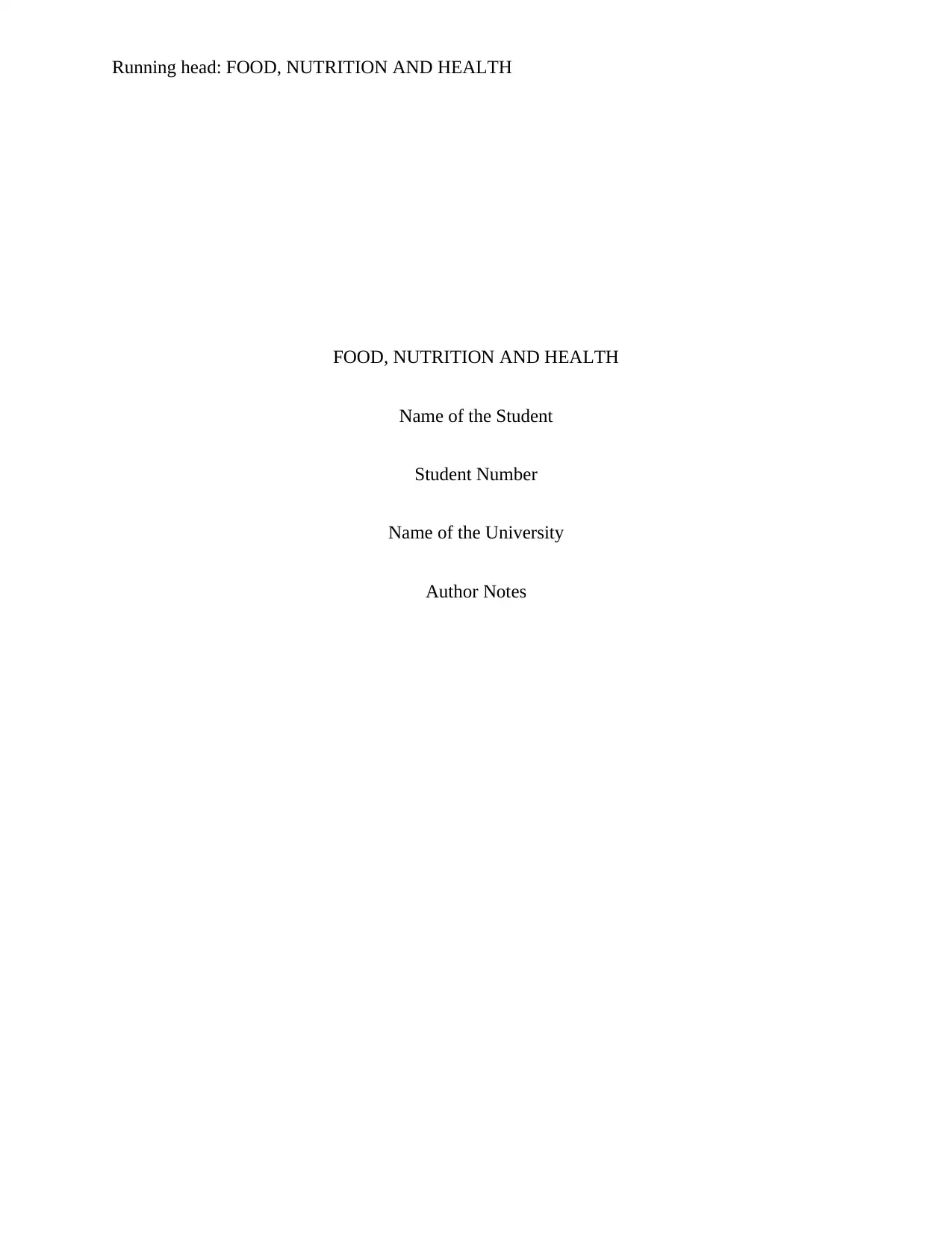
Running head: FOOD, NUTRITION AND HEALTH
FOOD, NUTRITION AND HEALTH
Name of the Student
Student Number
Name of the University
Author Notes
FOOD, NUTRITION AND HEALTH
Name of the Student
Student Number
Name of the University
Author Notes
Paraphrase This Document
Need a fresh take? Get an instant paraphrase of this document with our AI Paraphraser
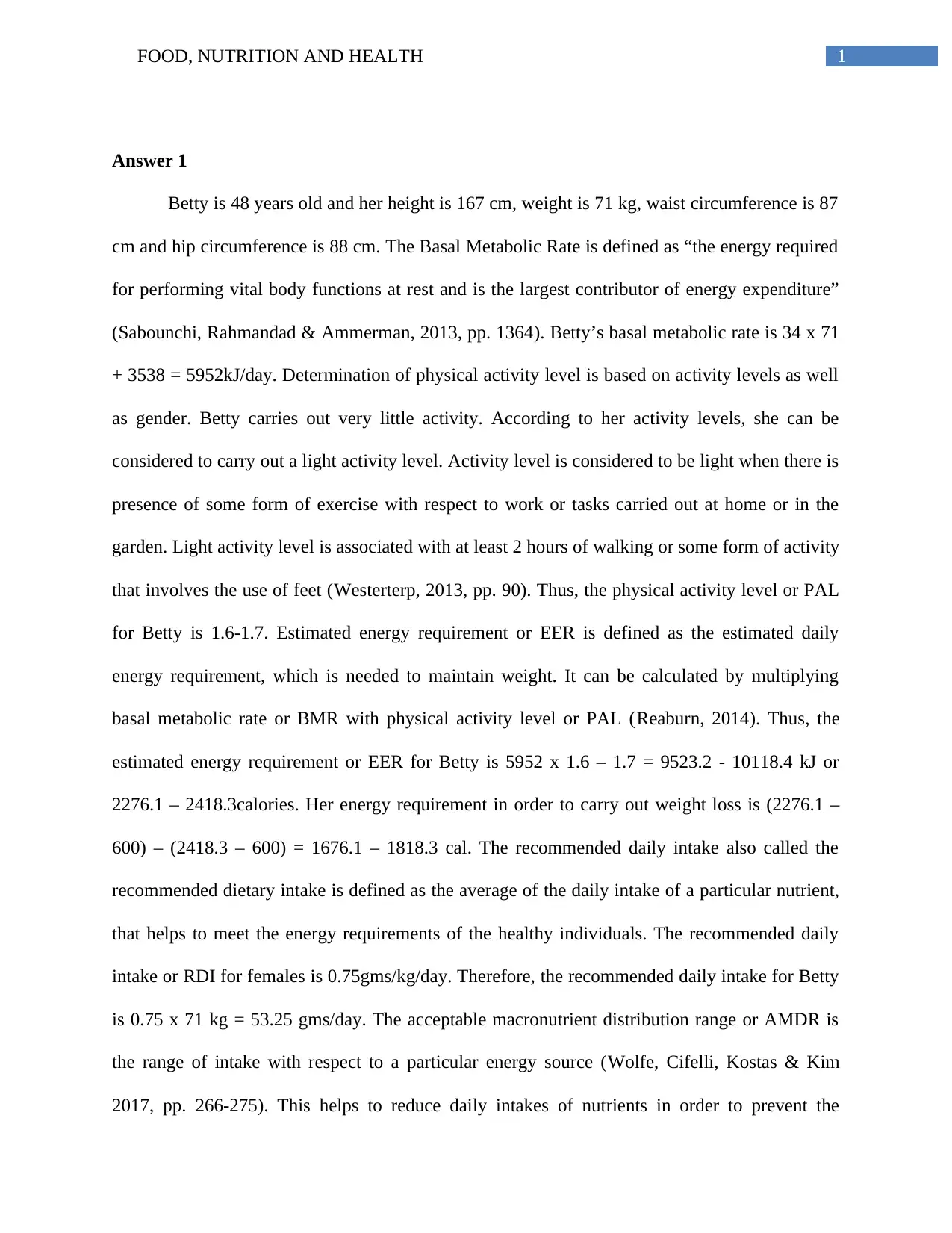
1FOOD, NUTRITION AND HEALTH
Answer 1
Betty is 48 years old and her height is 167 cm, weight is 71 kg, waist circumference is 87
cm and hip circumference is 88 cm. The Basal Metabolic Rate is defined as “the energy required
for performing vital body functions at rest and is the largest contributor of energy expenditure”
(Sabounchi, Rahmandad & Ammerman, 2013, pp. 1364). Betty’s basal metabolic rate is 34 x 71
+ 3538 = 5952kJ/day. Determination of physical activity level is based on activity levels as well
as gender. Betty carries out very little activity. According to her activity levels, she can be
considered to carry out a light activity level. Activity level is considered to be light when there is
presence of some form of exercise with respect to work or tasks carried out at home or in the
garden. Light activity level is associated with at least 2 hours of walking or some form of activity
that involves the use of feet (Westerterp, 2013, pp. 90). Thus, the physical activity level or PAL
for Betty is 1.6-1.7. Estimated energy requirement or EER is defined as the estimated daily
energy requirement, which is needed to maintain weight. It can be calculated by multiplying
basal metabolic rate or BMR with physical activity level or PAL (Reaburn, 2014). Thus, the
estimated energy requirement or EER for Betty is 5952 x 1.6 – 1.7 = 9523.2 - 10118.4 kJ or
2276.1 – 2418.3calories. Her energy requirement in order to carry out weight loss is (2276.1 –
600) – (2418.3 – 600) = 1676.1 – 1818.3 cal. The recommended daily intake also called the
recommended dietary intake is defined as the average of the daily intake of a particular nutrient,
that helps to meet the energy requirements of the healthy individuals. The recommended daily
intake or RDI for females is 0.75gms/kg/day. Therefore, the recommended daily intake for Betty
is 0.75 x 71 kg = 53.25 gms/day. The acceptable macronutrient distribution range or AMDR is
the range of intake with respect to a particular energy source (Wolfe, Cifelli, Kostas & Kim
2017, pp. 266-275). This helps to reduce daily intakes of nutrients in order to prevent the
Answer 1
Betty is 48 years old and her height is 167 cm, weight is 71 kg, waist circumference is 87
cm and hip circumference is 88 cm. The Basal Metabolic Rate is defined as “the energy required
for performing vital body functions at rest and is the largest contributor of energy expenditure”
(Sabounchi, Rahmandad & Ammerman, 2013, pp. 1364). Betty’s basal metabolic rate is 34 x 71
+ 3538 = 5952kJ/day. Determination of physical activity level is based on activity levels as well
as gender. Betty carries out very little activity. According to her activity levels, she can be
considered to carry out a light activity level. Activity level is considered to be light when there is
presence of some form of exercise with respect to work or tasks carried out at home or in the
garden. Light activity level is associated with at least 2 hours of walking or some form of activity
that involves the use of feet (Westerterp, 2013, pp. 90). Thus, the physical activity level or PAL
for Betty is 1.6-1.7. Estimated energy requirement or EER is defined as the estimated daily
energy requirement, which is needed to maintain weight. It can be calculated by multiplying
basal metabolic rate or BMR with physical activity level or PAL (Reaburn, 2014). Thus, the
estimated energy requirement or EER for Betty is 5952 x 1.6 – 1.7 = 9523.2 - 10118.4 kJ or
2276.1 – 2418.3calories. Her energy requirement in order to carry out weight loss is (2276.1 –
600) – (2418.3 – 600) = 1676.1 – 1818.3 cal. The recommended daily intake also called the
recommended dietary intake is defined as the average of the daily intake of a particular nutrient,
that helps to meet the energy requirements of the healthy individuals. The recommended daily
intake or RDI for females is 0.75gms/kg/day. Therefore, the recommended daily intake for Betty
is 0.75 x 71 kg = 53.25 gms/day. The acceptable macronutrient distribution range or AMDR is
the range of intake with respect to a particular energy source (Wolfe, Cifelli, Kostas & Kim
2017, pp. 266-275). This helps to reduce daily intakes of nutrients in order to prevent the
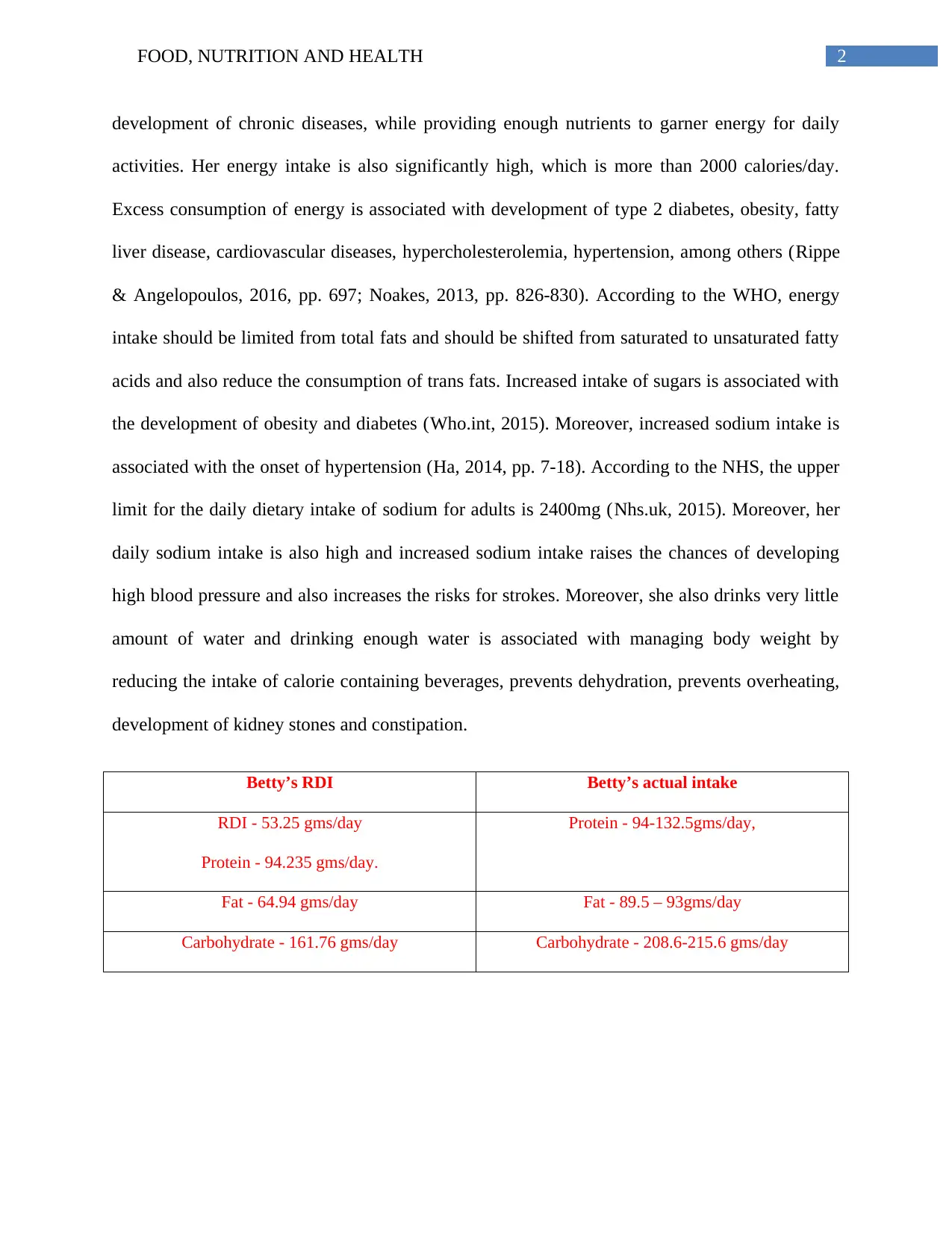
2FOOD, NUTRITION AND HEALTH
development of chronic diseases, while providing enough nutrients to garner energy for daily
activities. Her energy intake is also significantly high, which is more than 2000 calories/day.
Excess consumption of energy is associated with development of type 2 diabetes, obesity, fatty
liver disease, cardiovascular diseases, hypercholesterolemia, hypertension, among others (Rippe
& Angelopoulos, 2016, pp. 697; Noakes, 2013, pp. 826-830). According to the WHO, energy
intake should be limited from total fats and should be shifted from saturated to unsaturated fatty
acids and also reduce the consumption of trans fats. Increased intake of sugars is associated with
the development of obesity and diabetes (Who.int, 2015). Moreover, increased sodium intake is
associated with the onset of hypertension (Ha, 2014, pp. 7-18). According to the NHS, the upper
limit for the daily dietary intake of sodium for adults is 2400mg (Nhs.uk, 2015). Moreover, her
daily sodium intake is also high and increased sodium intake raises the chances of developing
high blood pressure and also increases the risks for strokes. Moreover, she also drinks very little
amount of water and drinking enough water is associated with managing body weight by
reducing the intake of calorie containing beverages, prevents dehydration, prevents overheating,
development of kidney stones and constipation.
Betty’s RDI Betty’s actual intake
RDI - 53.25 gms/day
Protein - 94.235 gms/day.
Protein - 94-132.5gms/day,
Fat - 64.94 gms/day Fat - 89.5 – 93gms/day
Carbohydrate - 161.76 gms/day Carbohydrate - 208.6-215.6 gms/day
development of chronic diseases, while providing enough nutrients to garner energy for daily
activities. Her energy intake is also significantly high, which is more than 2000 calories/day.
Excess consumption of energy is associated with development of type 2 diabetes, obesity, fatty
liver disease, cardiovascular diseases, hypercholesterolemia, hypertension, among others (Rippe
& Angelopoulos, 2016, pp. 697; Noakes, 2013, pp. 826-830). According to the WHO, energy
intake should be limited from total fats and should be shifted from saturated to unsaturated fatty
acids and also reduce the consumption of trans fats. Increased intake of sugars is associated with
the development of obesity and diabetes (Who.int, 2015). Moreover, increased sodium intake is
associated with the onset of hypertension (Ha, 2014, pp. 7-18). According to the NHS, the upper
limit for the daily dietary intake of sodium for adults is 2400mg (Nhs.uk, 2015). Moreover, her
daily sodium intake is also high and increased sodium intake raises the chances of developing
high blood pressure and also increases the risks for strokes. Moreover, she also drinks very little
amount of water and drinking enough water is associated with managing body weight by
reducing the intake of calorie containing beverages, prevents dehydration, prevents overheating,
development of kidney stones and constipation.
Betty’s RDI Betty’s actual intake
RDI - 53.25 gms/day
Protein - 94.235 gms/day.
Protein - 94-132.5gms/day,
Fat - 64.94 gms/day Fat - 89.5 – 93gms/day
Carbohydrate - 161.76 gms/day Carbohydrate - 208.6-215.6 gms/day
⊘ This is a preview!⊘
Do you want full access?
Subscribe today to unlock all pages.

Trusted by 1+ million students worldwide
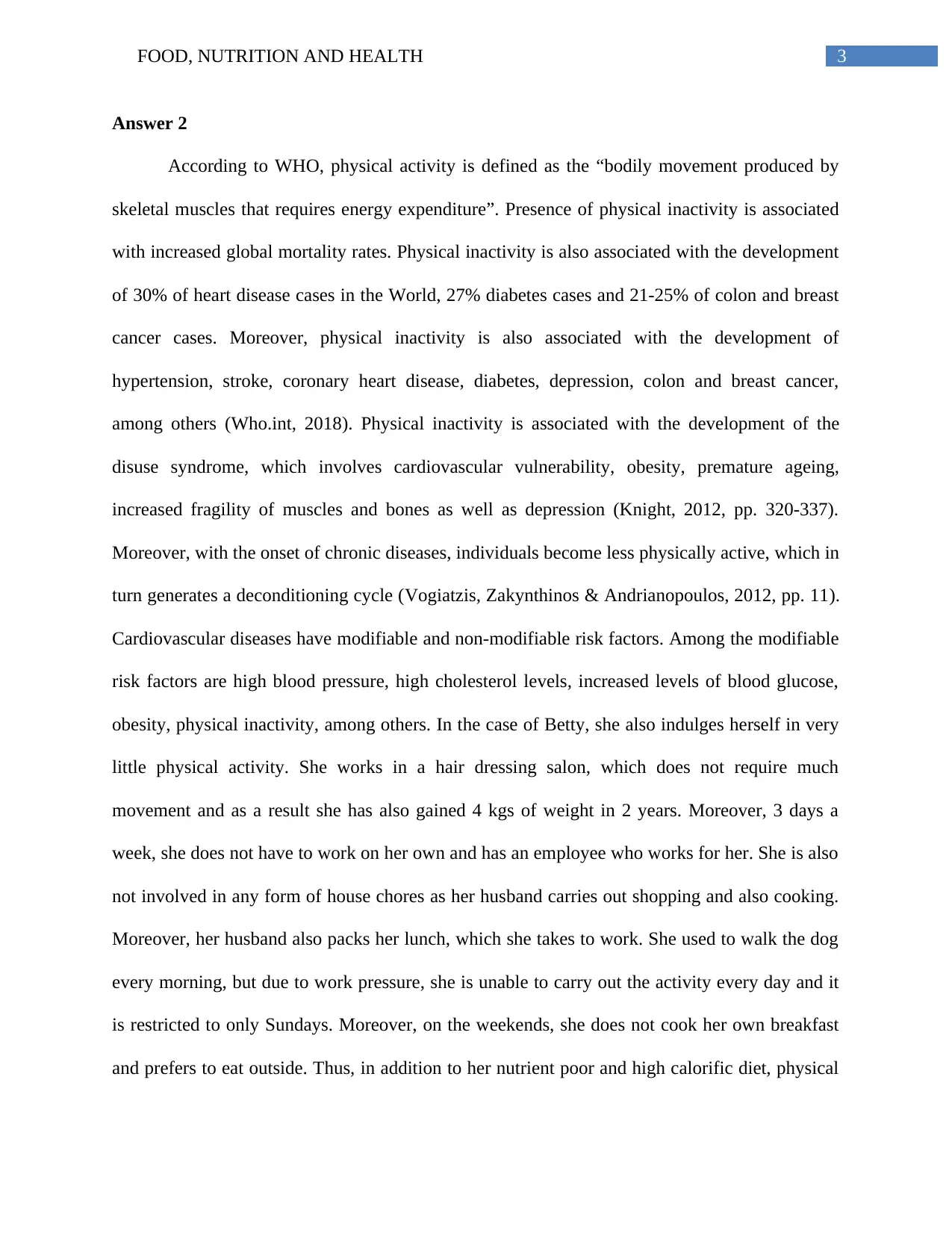
3FOOD, NUTRITION AND HEALTH
Answer 2
According to WHO, physical activity is defined as the “bodily movement produced by
skeletal muscles that requires energy expenditure”. Presence of physical inactivity is associated
with increased global mortality rates. Physical inactivity is also associated with the development
of 30% of heart disease cases in the World, 27% diabetes cases and 21-25% of colon and breast
cancer cases. Moreover, physical inactivity is also associated with the development of
hypertension, stroke, coronary heart disease, diabetes, depression, colon and breast cancer,
among others (Who.int, 2018). Physical inactivity is associated with the development of the
disuse syndrome, which involves cardiovascular vulnerability, obesity, premature ageing,
increased fragility of muscles and bones as well as depression (Knight, 2012, pp. 320-337).
Moreover, with the onset of chronic diseases, individuals become less physically active, which in
turn generates a deconditioning cycle (Vogiatzis, Zakynthinos & Andrianopoulos, 2012, pp. 11).
Cardiovascular diseases have modifiable and non-modifiable risk factors. Among the modifiable
risk factors are high blood pressure, high cholesterol levels, increased levels of blood glucose,
obesity, physical inactivity, among others. In the case of Betty, she also indulges herself in very
little physical activity. She works in a hair dressing salon, which does not require much
movement and as a result she has also gained 4 kgs of weight in 2 years. Moreover, 3 days a
week, she does not have to work on her own and has an employee who works for her. She is also
not involved in any form of house chores as her husband carries out shopping and also cooking.
Moreover, her husband also packs her lunch, which she takes to work. She used to walk the dog
every morning, but due to work pressure, she is unable to carry out the activity every day and it
is restricted to only Sundays. Moreover, on the weekends, she does not cook her own breakfast
and prefers to eat outside. Thus, in addition to her nutrient poor and high calorific diet, physical
Answer 2
According to WHO, physical activity is defined as the “bodily movement produced by
skeletal muscles that requires energy expenditure”. Presence of physical inactivity is associated
with increased global mortality rates. Physical inactivity is also associated with the development
of 30% of heart disease cases in the World, 27% diabetes cases and 21-25% of colon and breast
cancer cases. Moreover, physical inactivity is also associated with the development of
hypertension, stroke, coronary heart disease, diabetes, depression, colon and breast cancer,
among others (Who.int, 2018). Physical inactivity is associated with the development of the
disuse syndrome, which involves cardiovascular vulnerability, obesity, premature ageing,
increased fragility of muscles and bones as well as depression (Knight, 2012, pp. 320-337).
Moreover, with the onset of chronic diseases, individuals become less physically active, which in
turn generates a deconditioning cycle (Vogiatzis, Zakynthinos & Andrianopoulos, 2012, pp. 11).
Cardiovascular diseases have modifiable and non-modifiable risk factors. Among the modifiable
risk factors are high blood pressure, high cholesterol levels, increased levels of blood glucose,
obesity, physical inactivity, among others. In the case of Betty, she also indulges herself in very
little physical activity. She works in a hair dressing salon, which does not require much
movement and as a result she has also gained 4 kgs of weight in 2 years. Moreover, 3 days a
week, she does not have to work on her own and has an employee who works for her. She is also
not involved in any form of house chores as her husband carries out shopping and also cooking.
Moreover, her husband also packs her lunch, which she takes to work. She used to walk the dog
every morning, but due to work pressure, she is unable to carry out the activity every day and it
is restricted to only Sundays. Moreover, on the weekends, she does not cook her own breakfast
and prefers to eat outside. Thus, in addition to her nutrient poor and high calorific diet, physical
Paraphrase This Document
Need a fresh take? Get an instant paraphrase of this document with our AI Paraphraser
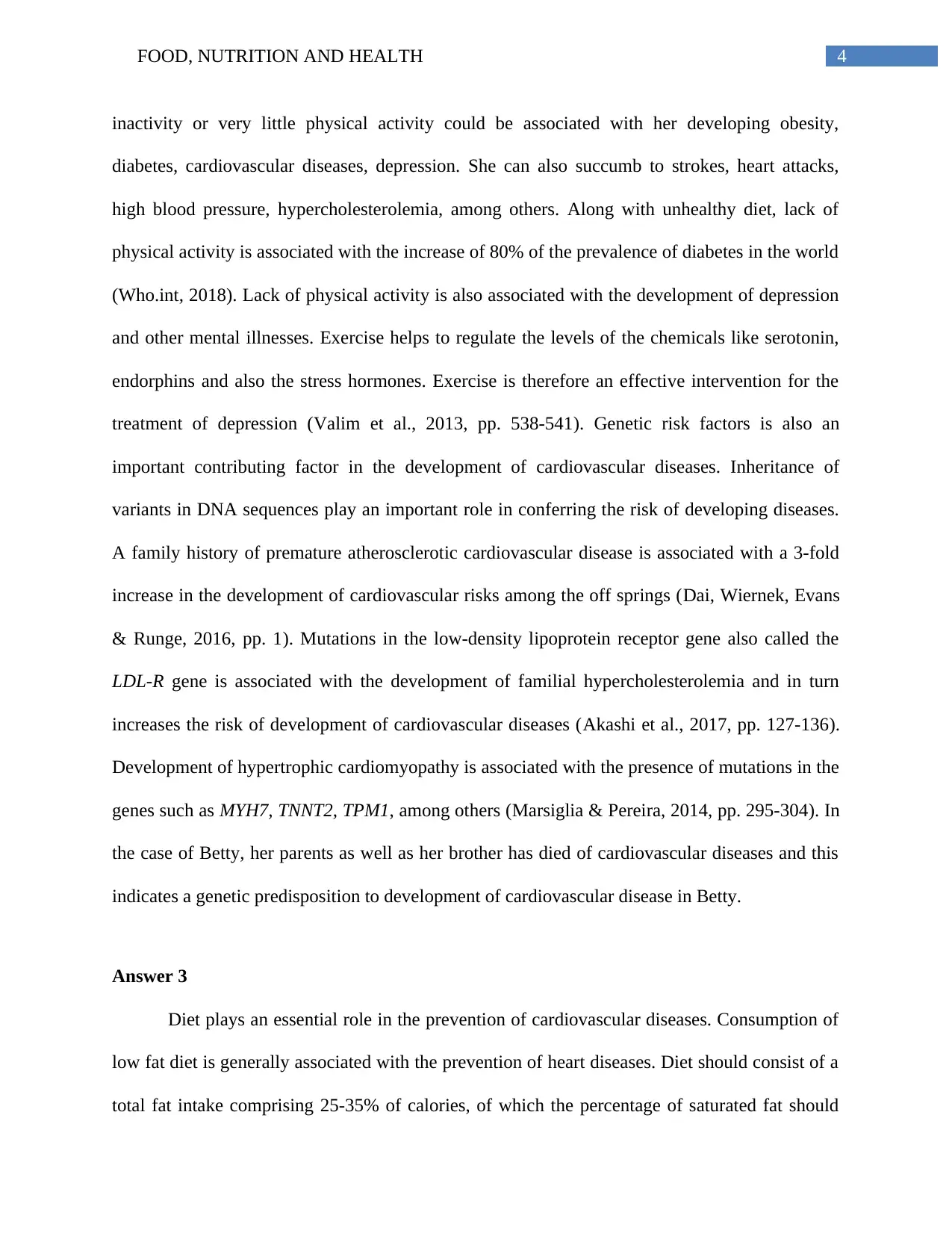
4FOOD, NUTRITION AND HEALTH
inactivity or very little physical activity could be associated with her developing obesity,
diabetes, cardiovascular diseases, depression. She can also succumb to strokes, heart attacks,
high blood pressure, hypercholesterolemia, among others. Along with unhealthy diet, lack of
physical activity is associated with the increase of 80% of the prevalence of diabetes in the world
(Who.int, 2018). Lack of physical activity is also associated with the development of depression
and other mental illnesses. Exercise helps to regulate the levels of the chemicals like serotonin,
endorphins and also the stress hormones. Exercise is therefore an effective intervention for the
treatment of depression (Valim et al., 2013, pp. 538-541). Genetic risk factors is also an
important contributing factor in the development of cardiovascular diseases. Inheritance of
variants in DNA sequences play an important role in conferring the risk of developing diseases.
A family history of premature atherosclerotic cardiovascular disease is associated with a 3-fold
increase in the development of cardiovascular risks among the off springs (Dai, Wiernek, Evans
& Runge, 2016, pp. 1). Mutations in the low-density lipoprotein receptor gene also called the
LDL-R gene is associated with the development of familial hypercholesterolemia and in turn
increases the risk of development of cardiovascular diseases (Akashi et al., 2017, pp. 127-136).
Development of hypertrophic cardiomyopathy is associated with the presence of mutations in the
genes such as MYH7, TNNT2, TPM1, among others (Marsiglia & Pereira, 2014, pp. 295-304). In
the case of Betty, her parents as well as her brother has died of cardiovascular diseases and this
indicates a genetic predisposition to development of cardiovascular disease in Betty.
Answer 3
Diet plays an essential role in the prevention of cardiovascular diseases. Consumption of
low fat diet is generally associated with the prevention of heart diseases. Diet should consist of a
total fat intake comprising 25-35% of calories, of which the percentage of saturated fat should
inactivity or very little physical activity could be associated with her developing obesity,
diabetes, cardiovascular diseases, depression. She can also succumb to strokes, heart attacks,
high blood pressure, hypercholesterolemia, among others. Along with unhealthy diet, lack of
physical activity is associated with the increase of 80% of the prevalence of diabetes in the world
(Who.int, 2018). Lack of physical activity is also associated with the development of depression
and other mental illnesses. Exercise helps to regulate the levels of the chemicals like serotonin,
endorphins and also the stress hormones. Exercise is therefore an effective intervention for the
treatment of depression (Valim et al., 2013, pp. 538-541). Genetic risk factors is also an
important contributing factor in the development of cardiovascular diseases. Inheritance of
variants in DNA sequences play an important role in conferring the risk of developing diseases.
A family history of premature atherosclerotic cardiovascular disease is associated with a 3-fold
increase in the development of cardiovascular risks among the off springs (Dai, Wiernek, Evans
& Runge, 2016, pp. 1). Mutations in the low-density lipoprotein receptor gene also called the
LDL-R gene is associated with the development of familial hypercholesterolemia and in turn
increases the risk of development of cardiovascular diseases (Akashi et al., 2017, pp. 127-136).
Development of hypertrophic cardiomyopathy is associated with the presence of mutations in the
genes such as MYH7, TNNT2, TPM1, among others (Marsiglia & Pereira, 2014, pp. 295-304). In
the case of Betty, her parents as well as her brother has died of cardiovascular diseases and this
indicates a genetic predisposition to development of cardiovascular disease in Betty.
Answer 3
Diet plays an essential role in the prevention of cardiovascular diseases. Consumption of
low fat diet is generally associated with the prevention of heart diseases. Diet should consist of a
total fat intake comprising 25-35% of calories, of which the percentage of saturated fat should
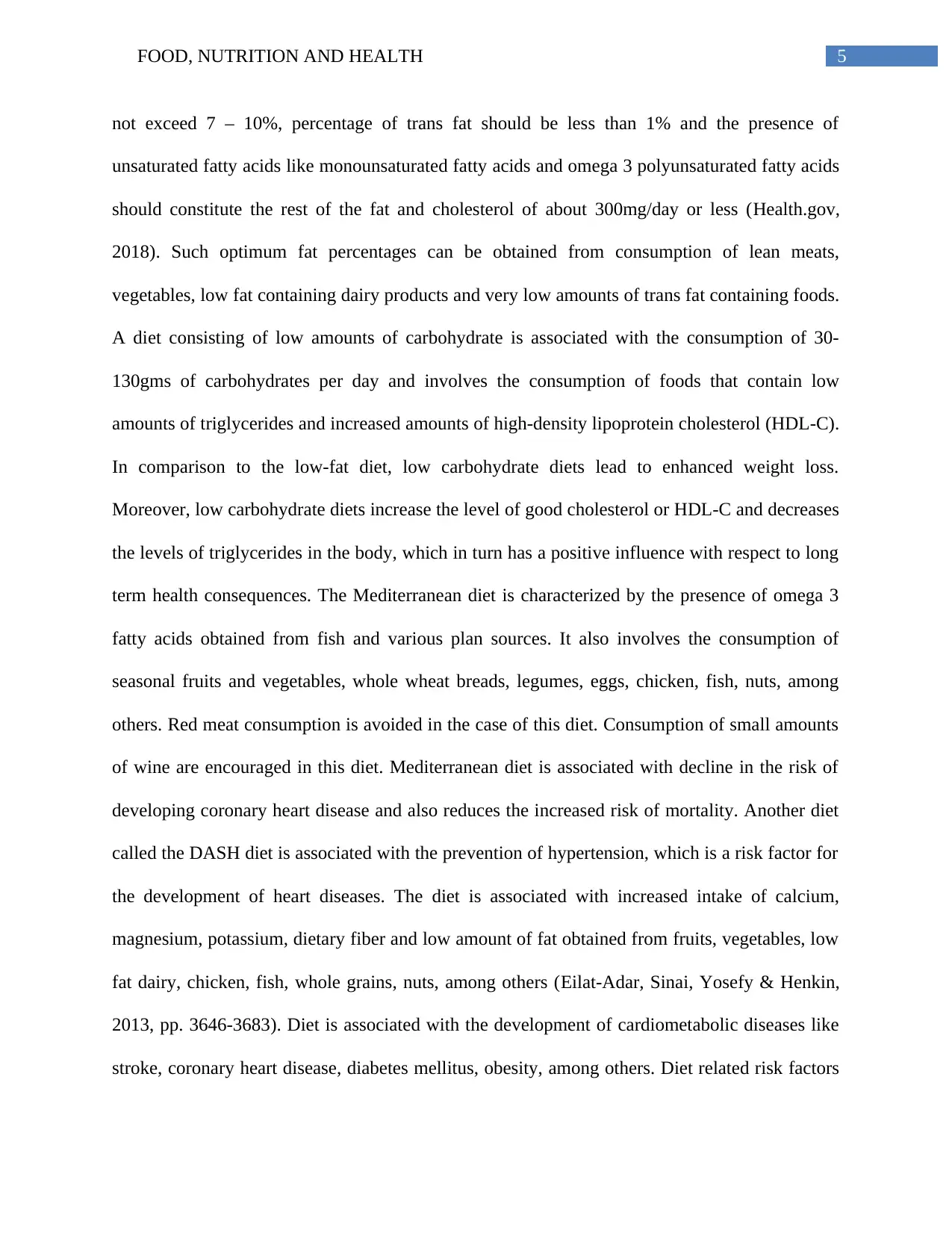
5FOOD, NUTRITION AND HEALTH
not exceed 7 – 10%, percentage of trans fat should be less than 1% and the presence of
unsaturated fatty acids like monounsaturated fatty acids and omega 3 polyunsaturated fatty acids
should constitute the rest of the fat and cholesterol of about 300mg/day or less (Health.gov,
2018). Such optimum fat percentages can be obtained from consumption of lean meats,
vegetables, low fat containing dairy products and very low amounts of trans fat containing foods.
A diet consisting of low amounts of carbohydrate is associated with the consumption of 30-
130gms of carbohydrates per day and involves the consumption of foods that contain low
amounts of triglycerides and increased amounts of high-density lipoprotein cholesterol (HDL-C).
In comparison to the low-fat diet, low carbohydrate diets lead to enhanced weight loss.
Moreover, low carbohydrate diets increase the level of good cholesterol or HDL-C and decreases
the levels of triglycerides in the body, which in turn has a positive influence with respect to long
term health consequences. The Mediterranean diet is characterized by the presence of omega 3
fatty acids obtained from fish and various plan sources. It also involves the consumption of
seasonal fruits and vegetables, whole wheat breads, legumes, eggs, chicken, fish, nuts, among
others. Red meat consumption is avoided in the case of this diet. Consumption of small amounts
of wine are encouraged in this diet. Mediterranean diet is associated with decline in the risk of
developing coronary heart disease and also reduces the increased risk of mortality. Another diet
called the DASH diet is associated with the prevention of hypertension, which is a risk factor for
the development of heart diseases. The diet is associated with increased intake of calcium,
magnesium, potassium, dietary fiber and low amount of fat obtained from fruits, vegetables, low
fat dairy, chicken, fish, whole grains, nuts, among others (Eilat-Adar, Sinai, Yosefy & Henkin,
2013, pp. 3646-3683). Diet is associated with the development of cardiometabolic diseases like
stroke, coronary heart disease, diabetes mellitus, obesity, among others. Diet related risk factors
not exceed 7 – 10%, percentage of trans fat should be less than 1% and the presence of
unsaturated fatty acids like monounsaturated fatty acids and omega 3 polyunsaturated fatty acids
should constitute the rest of the fat and cholesterol of about 300mg/day or less (Health.gov,
2018). Such optimum fat percentages can be obtained from consumption of lean meats,
vegetables, low fat containing dairy products and very low amounts of trans fat containing foods.
A diet consisting of low amounts of carbohydrate is associated with the consumption of 30-
130gms of carbohydrates per day and involves the consumption of foods that contain low
amounts of triglycerides and increased amounts of high-density lipoprotein cholesterol (HDL-C).
In comparison to the low-fat diet, low carbohydrate diets lead to enhanced weight loss.
Moreover, low carbohydrate diets increase the level of good cholesterol or HDL-C and decreases
the levels of triglycerides in the body, which in turn has a positive influence with respect to long
term health consequences. The Mediterranean diet is characterized by the presence of omega 3
fatty acids obtained from fish and various plan sources. It also involves the consumption of
seasonal fruits and vegetables, whole wheat breads, legumes, eggs, chicken, fish, nuts, among
others. Red meat consumption is avoided in the case of this diet. Consumption of small amounts
of wine are encouraged in this diet. Mediterranean diet is associated with decline in the risk of
developing coronary heart disease and also reduces the increased risk of mortality. Another diet
called the DASH diet is associated with the prevention of hypertension, which is a risk factor for
the development of heart diseases. The diet is associated with increased intake of calcium,
magnesium, potassium, dietary fiber and low amount of fat obtained from fruits, vegetables, low
fat dairy, chicken, fish, whole grains, nuts, among others (Eilat-Adar, Sinai, Yosefy & Henkin,
2013, pp. 3646-3683). Diet is associated with the development of cardiometabolic diseases like
stroke, coronary heart disease, diabetes mellitus, obesity, among others. Diet related risk factors
⊘ This is a preview!⊘
Do you want full access?
Subscribe today to unlock all pages.

Trusted by 1+ million students worldwide
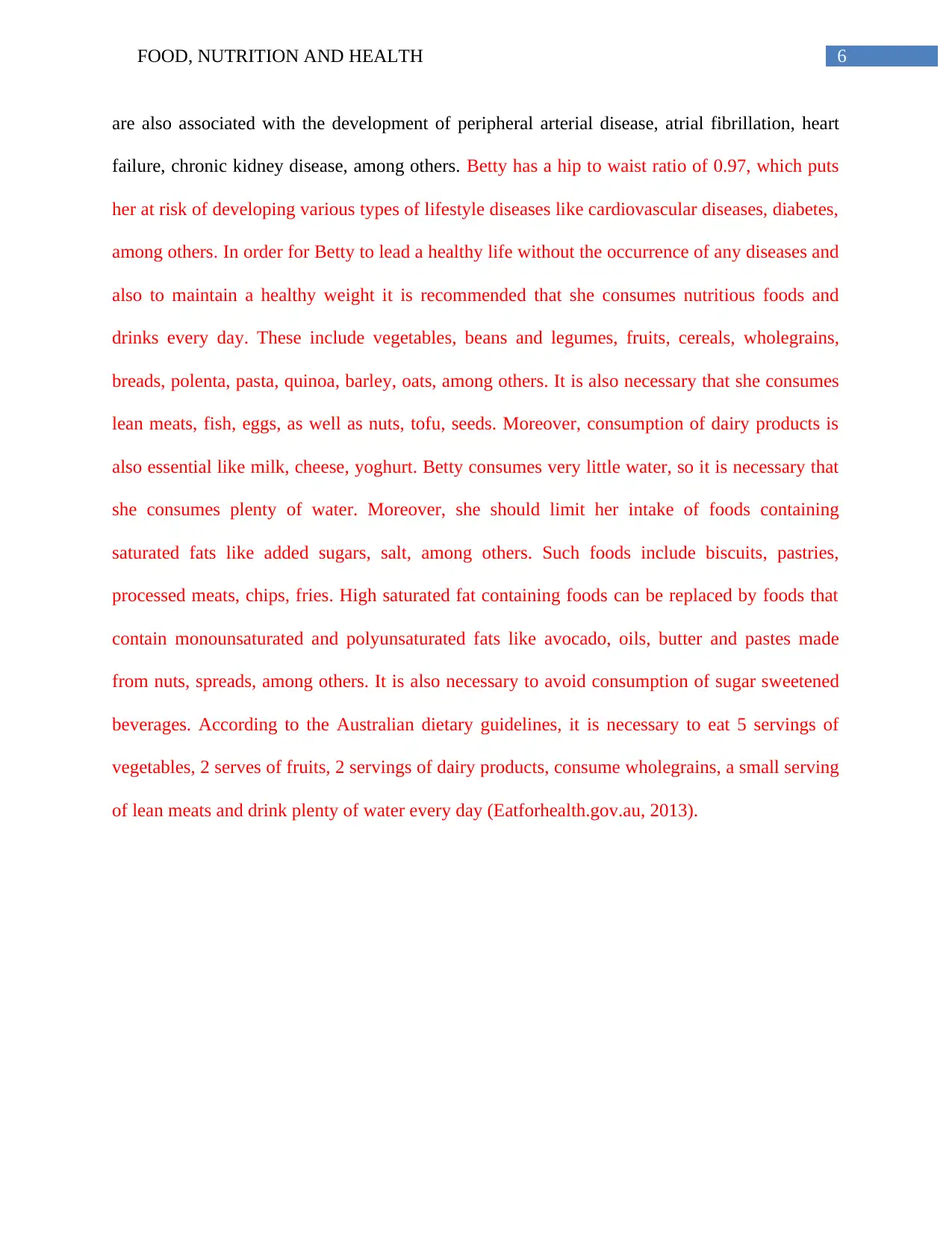
6FOOD, NUTRITION AND HEALTH
are also associated with the development of peripheral arterial disease, atrial fibrillation, heart
failure, chronic kidney disease, among others. Betty has a hip to waist ratio of 0.97, which puts
her at risk of developing various types of lifestyle diseases like cardiovascular diseases, diabetes,
among others. In order for Betty to lead a healthy life without the occurrence of any diseases and
also to maintain a healthy weight it is recommended that she consumes nutritious foods and
drinks every day. These include vegetables, beans and legumes, fruits, cereals, wholegrains,
breads, polenta, pasta, quinoa, barley, oats, among others. It is also necessary that she consumes
lean meats, fish, eggs, as well as nuts, tofu, seeds. Moreover, consumption of dairy products is
also essential like milk, cheese, yoghurt. Betty consumes very little water, so it is necessary that
she consumes plenty of water. Moreover, she should limit her intake of foods containing
saturated fats like added sugars, salt, among others. Such foods include biscuits, pastries,
processed meats, chips, fries. High saturated fat containing foods can be replaced by foods that
contain monounsaturated and polyunsaturated fats like avocado, oils, butter and pastes made
from nuts, spreads, among others. It is also necessary to avoid consumption of sugar sweetened
beverages. According to the Australian dietary guidelines, it is necessary to eat 5 servings of
vegetables, 2 serves of fruits, 2 servings of dairy products, consume wholegrains, a small serving
of lean meats and drink plenty of water every day (Eatforhealth.gov.au, 2013).
are also associated with the development of peripheral arterial disease, atrial fibrillation, heart
failure, chronic kidney disease, among others. Betty has a hip to waist ratio of 0.97, which puts
her at risk of developing various types of lifestyle diseases like cardiovascular diseases, diabetes,
among others. In order for Betty to lead a healthy life without the occurrence of any diseases and
also to maintain a healthy weight it is recommended that she consumes nutritious foods and
drinks every day. These include vegetables, beans and legumes, fruits, cereals, wholegrains,
breads, polenta, pasta, quinoa, barley, oats, among others. It is also necessary that she consumes
lean meats, fish, eggs, as well as nuts, tofu, seeds. Moreover, consumption of dairy products is
also essential like milk, cheese, yoghurt. Betty consumes very little water, so it is necessary that
she consumes plenty of water. Moreover, she should limit her intake of foods containing
saturated fats like added sugars, salt, among others. Such foods include biscuits, pastries,
processed meats, chips, fries. High saturated fat containing foods can be replaced by foods that
contain monounsaturated and polyunsaturated fats like avocado, oils, butter and pastes made
from nuts, spreads, among others. It is also necessary to avoid consumption of sugar sweetened
beverages. According to the Australian dietary guidelines, it is necessary to eat 5 servings of
vegetables, 2 serves of fruits, 2 servings of dairy products, consume wholegrains, a small serving
of lean meats and drink plenty of water every day (Eatforhealth.gov.au, 2013).
Paraphrase This Document
Need a fresh take? Get an instant paraphrase of this document with our AI Paraphraser
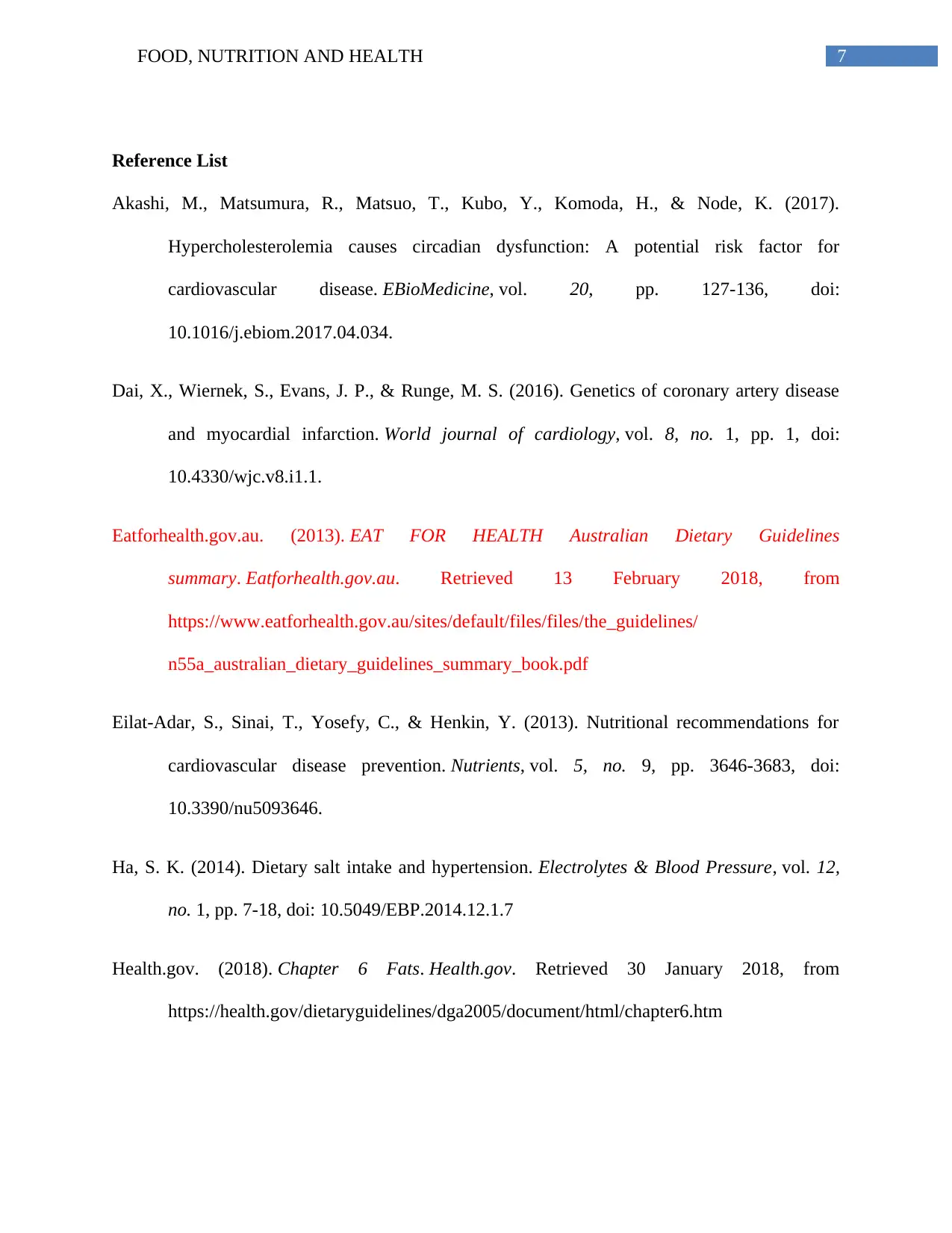
7FOOD, NUTRITION AND HEALTH
Reference List
Akashi, M., Matsumura, R., Matsuo, T., Kubo, Y., Komoda, H., & Node, K. (2017).
Hypercholesterolemia causes circadian dysfunction: A potential risk factor for
cardiovascular disease. EBioMedicine, vol. 20, pp. 127-136, doi:
10.1016/j.ebiom.2017.04.034.
Dai, X., Wiernek, S., Evans, J. P., & Runge, M. S. (2016). Genetics of coronary artery disease
and myocardial infarction. World journal of cardiology, vol. 8, no. 1, pp. 1, doi:
10.4330/wjc.v8.i1.1.
Eatforhealth.gov.au. (2013). EAT FOR HEALTH Australian Dietary Guidelines
summary. Eatforhealth.gov.au. Retrieved 13 February 2018, from
https://www.eatforhealth.gov.au/sites/default/files/files/the_guidelines/
n55a_australian_dietary_guidelines_summary_book.pdf
Eilat-Adar, S., Sinai, T., Yosefy, C., & Henkin, Y. (2013). Nutritional recommendations for
cardiovascular disease prevention. Nutrients, vol. 5, no. 9, pp. 3646-3683, doi:
10.3390/nu5093646.
Ha, S. K. (2014). Dietary salt intake and hypertension. Electrolytes & Blood Pressure, vol. 12,
no. 1, pp. 7-18, doi: 10.5049/EBP.2014.12.1.7
Health.gov. (2018). Chapter 6 Fats. Health.gov. Retrieved 30 January 2018, from
https://health.gov/dietaryguidelines/dga2005/document/html/chapter6.htm
Reference List
Akashi, M., Matsumura, R., Matsuo, T., Kubo, Y., Komoda, H., & Node, K. (2017).
Hypercholesterolemia causes circadian dysfunction: A potential risk factor for
cardiovascular disease. EBioMedicine, vol. 20, pp. 127-136, doi:
10.1016/j.ebiom.2017.04.034.
Dai, X., Wiernek, S., Evans, J. P., & Runge, M. S. (2016). Genetics of coronary artery disease
and myocardial infarction. World journal of cardiology, vol. 8, no. 1, pp. 1, doi:
10.4330/wjc.v8.i1.1.
Eatforhealth.gov.au. (2013). EAT FOR HEALTH Australian Dietary Guidelines
summary. Eatforhealth.gov.au. Retrieved 13 February 2018, from
https://www.eatforhealth.gov.au/sites/default/files/files/the_guidelines/
n55a_australian_dietary_guidelines_summary_book.pdf
Eilat-Adar, S., Sinai, T., Yosefy, C., & Henkin, Y. (2013). Nutritional recommendations for
cardiovascular disease prevention. Nutrients, vol. 5, no. 9, pp. 3646-3683, doi:
10.3390/nu5093646.
Ha, S. K. (2014). Dietary salt intake and hypertension. Electrolytes & Blood Pressure, vol. 12,
no. 1, pp. 7-18, doi: 10.5049/EBP.2014.12.1.7
Health.gov. (2018). Chapter 6 Fats. Health.gov. Retrieved 30 January 2018, from
https://health.gov/dietaryguidelines/dga2005/document/html/chapter6.htm
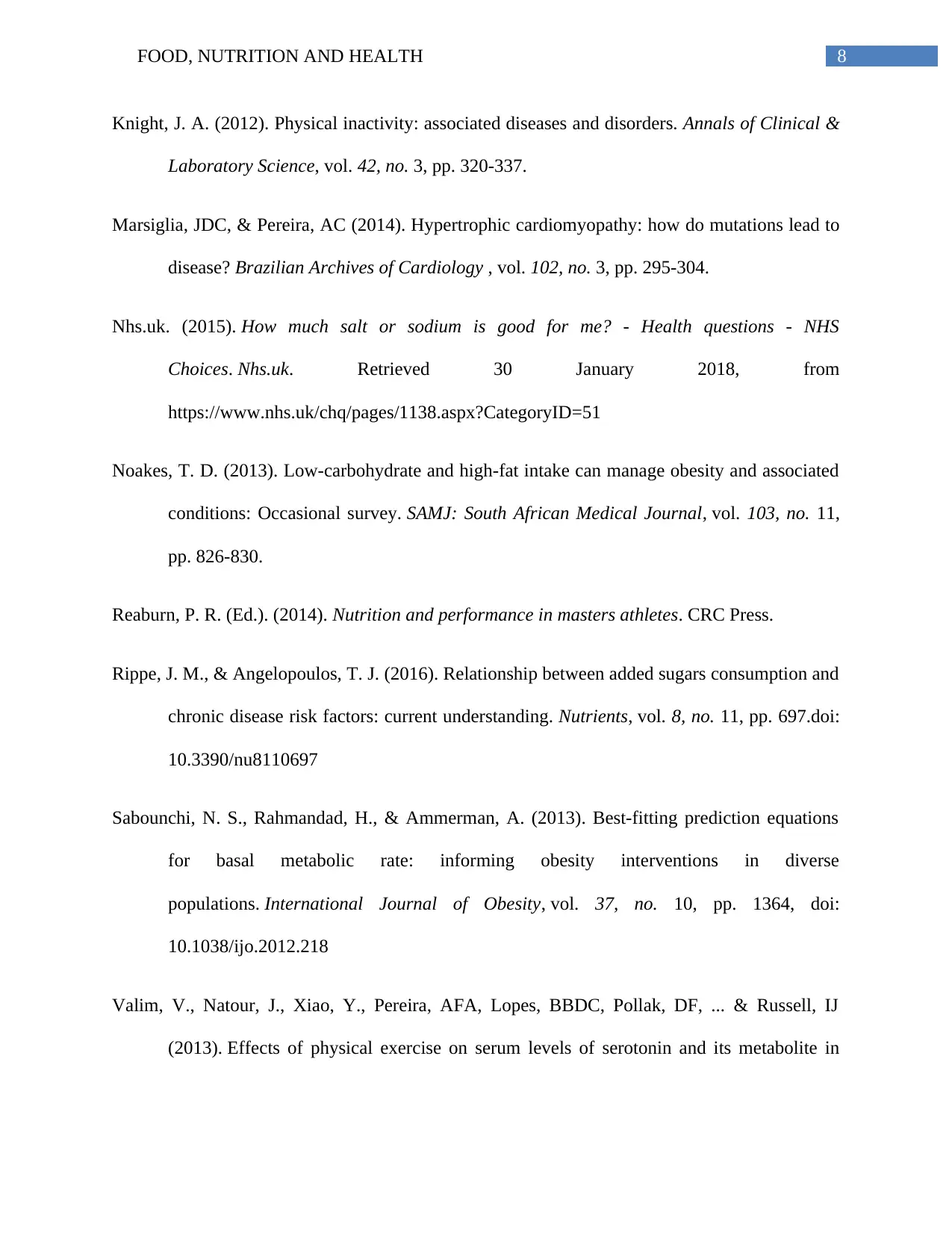
8FOOD, NUTRITION AND HEALTH
Knight, J. A. (2012). Physical inactivity: associated diseases and disorders. Annals of Clinical &
Laboratory Science, vol. 42, no. 3, pp. 320-337.
Marsiglia, JDC, & Pereira, AC (2014). Hypertrophic cardiomyopathy: how do mutations lead to
disease? Brazilian Archives of Cardiology , vol. 102, no. 3, pp. 295-304.
Nhs.uk. (2015). How much salt or sodium is good for me? - Health questions - NHS
Choices. Nhs.uk. Retrieved 30 January 2018, from
https://www.nhs.uk/chq/pages/1138.aspx?CategoryID=51
Noakes, T. D. (2013). Low-carbohydrate and high-fat intake can manage obesity and associated
conditions: Occasional survey. SAMJ: South African Medical Journal, vol. 103, no. 11,
pp. 826-830.
Reaburn, P. R. (Ed.). (2014). Nutrition and performance in masters athletes. CRC Press.
Rippe, J. M., & Angelopoulos, T. J. (2016). Relationship between added sugars consumption and
chronic disease risk factors: current understanding. Nutrients, vol. 8, no. 11, pp. 697.doi:
10.3390/nu8110697
Sabounchi, N. S., Rahmandad, H., & Ammerman, A. (2013). Best-fitting prediction equations
for basal metabolic rate: informing obesity interventions in diverse
populations. International Journal of Obesity, vol. 37, no. 10, pp. 1364, doi:
10.1038/ijo.2012.218
Valim, V., Natour, J., Xiao, Y., Pereira, AFA, Lopes, BBDC, Pollak, DF, ... & Russell, IJ
(2013). Effects of physical exercise on serum levels of serotonin and its metabolite in
Knight, J. A. (2012). Physical inactivity: associated diseases and disorders. Annals of Clinical &
Laboratory Science, vol. 42, no. 3, pp. 320-337.
Marsiglia, JDC, & Pereira, AC (2014). Hypertrophic cardiomyopathy: how do mutations lead to
disease? Brazilian Archives of Cardiology , vol. 102, no. 3, pp. 295-304.
Nhs.uk. (2015). How much salt or sodium is good for me? - Health questions - NHS
Choices. Nhs.uk. Retrieved 30 January 2018, from
https://www.nhs.uk/chq/pages/1138.aspx?CategoryID=51
Noakes, T. D. (2013). Low-carbohydrate and high-fat intake can manage obesity and associated
conditions: Occasional survey. SAMJ: South African Medical Journal, vol. 103, no. 11,
pp. 826-830.
Reaburn, P. R. (Ed.). (2014). Nutrition and performance in masters athletes. CRC Press.
Rippe, J. M., & Angelopoulos, T. J. (2016). Relationship between added sugars consumption and
chronic disease risk factors: current understanding. Nutrients, vol. 8, no. 11, pp. 697.doi:
10.3390/nu8110697
Sabounchi, N. S., Rahmandad, H., & Ammerman, A. (2013). Best-fitting prediction equations
for basal metabolic rate: informing obesity interventions in diverse
populations. International Journal of Obesity, vol. 37, no. 10, pp. 1364, doi:
10.1038/ijo.2012.218
Valim, V., Natour, J., Xiao, Y., Pereira, AFA, Lopes, BBDC, Pollak, DF, ... & Russell, IJ
(2013). Effects of physical exercise on serum levels of serotonin and its metabolite in
⊘ This is a preview!⊘
Do you want full access?
Subscribe today to unlock all pages.

Trusted by 1+ million students worldwide
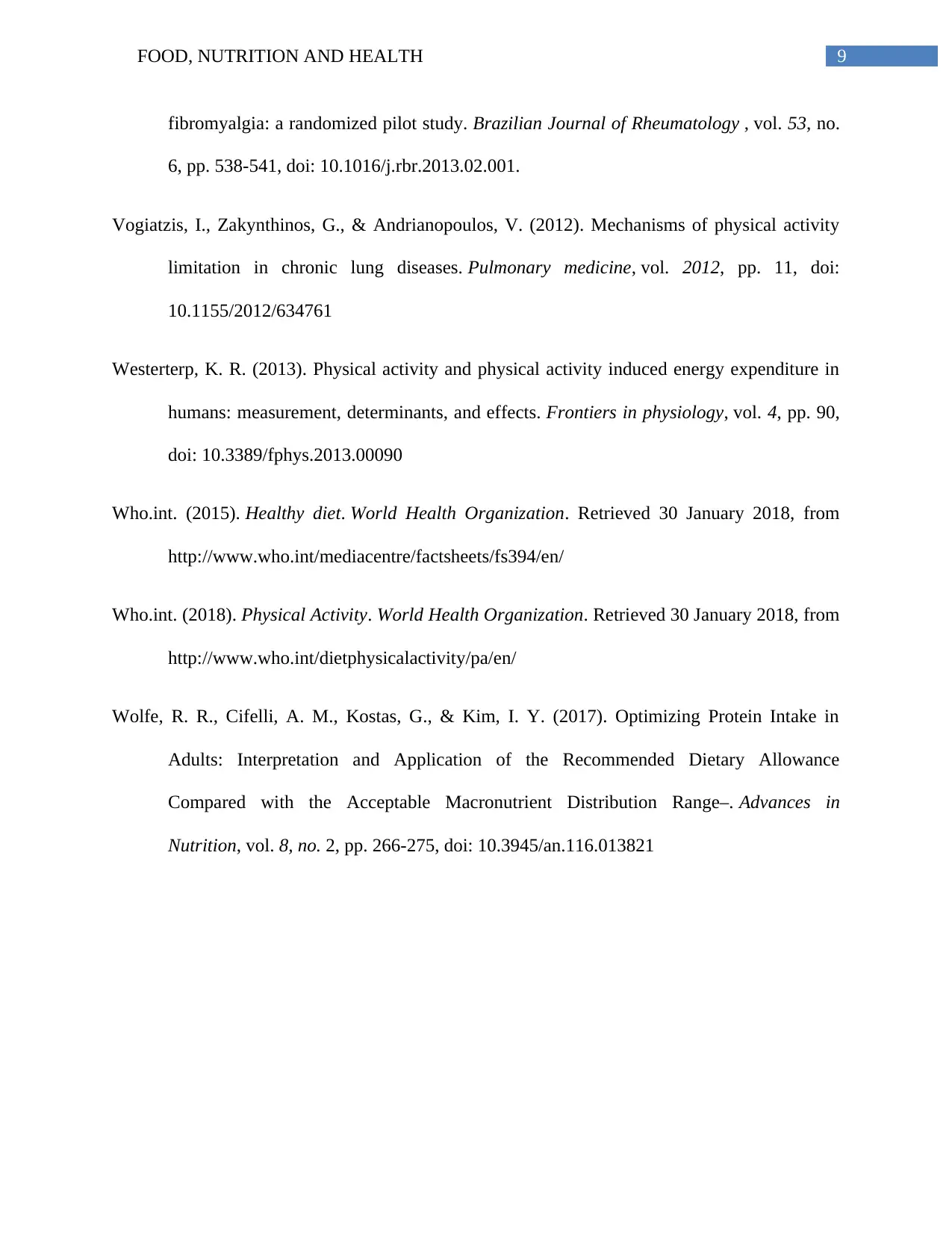
9FOOD, NUTRITION AND HEALTH
fibromyalgia: a randomized pilot study. Brazilian Journal of Rheumatology , vol. 53, no.
6, pp. 538-541, doi: 10.1016/j.rbr.2013.02.001.
Vogiatzis, I., Zakynthinos, G., & Andrianopoulos, V. (2012). Mechanisms of physical activity
limitation in chronic lung diseases. Pulmonary medicine, vol. 2012, pp. 11, doi:
10.1155/2012/634761
Westerterp, K. R. (2013). Physical activity and physical activity induced energy expenditure in
humans: measurement, determinants, and effects. Frontiers in physiology, vol. 4, pp. 90,
doi: 10.3389/fphys.2013.00090
Who.int. (2015). Healthy diet. World Health Organization. Retrieved 30 January 2018, from
http://www.who.int/mediacentre/factsheets/fs394/en/
Who.int. (2018). Physical Activity. World Health Organization. Retrieved 30 January 2018, from
http://www.who.int/dietphysicalactivity/pa/en/
Wolfe, R. R., Cifelli, A. M., Kostas, G., & Kim, I. Y. (2017). Optimizing Protein Intake in
Adults: Interpretation and Application of the Recommended Dietary Allowance
Compared with the Acceptable Macronutrient Distribution Range–. Advances in
Nutrition, vol. 8, no. 2, pp. 266-275, doi: 10.3945/an.116.013821
fibromyalgia: a randomized pilot study. Brazilian Journal of Rheumatology , vol. 53, no.
6, pp. 538-541, doi: 10.1016/j.rbr.2013.02.001.
Vogiatzis, I., Zakynthinos, G., & Andrianopoulos, V. (2012). Mechanisms of physical activity
limitation in chronic lung diseases. Pulmonary medicine, vol. 2012, pp. 11, doi:
10.1155/2012/634761
Westerterp, K. R. (2013). Physical activity and physical activity induced energy expenditure in
humans: measurement, determinants, and effects. Frontiers in physiology, vol. 4, pp. 90,
doi: 10.3389/fphys.2013.00090
Who.int. (2015). Healthy diet. World Health Organization. Retrieved 30 January 2018, from
http://www.who.int/mediacentre/factsheets/fs394/en/
Who.int. (2018). Physical Activity. World Health Organization. Retrieved 30 January 2018, from
http://www.who.int/dietphysicalactivity/pa/en/
Wolfe, R. R., Cifelli, A. M., Kostas, G., & Kim, I. Y. (2017). Optimizing Protein Intake in
Adults: Interpretation and Application of the Recommended Dietary Allowance
Compared with the Acceptable Macronutrient Distribution Range–. Advances in
Nutrition, vol. 8, no. 2, pp. 266-275, doi: 10.3945/an.116.013821
1 out of 10
Related Documents
Your All-in-One AI-Powered Toolkit for Academic Success.
+13062052269
info@desklib.com
Available 24*7 on WhatsApp / Email
![[object Object]](/_next/static/media/star-bottom.7253800d.svg)
Unlock your academic potential
Copyright © 2020–2025 A2Z Services. All Rights Reserved. Developed and managed by ZUCOL.





